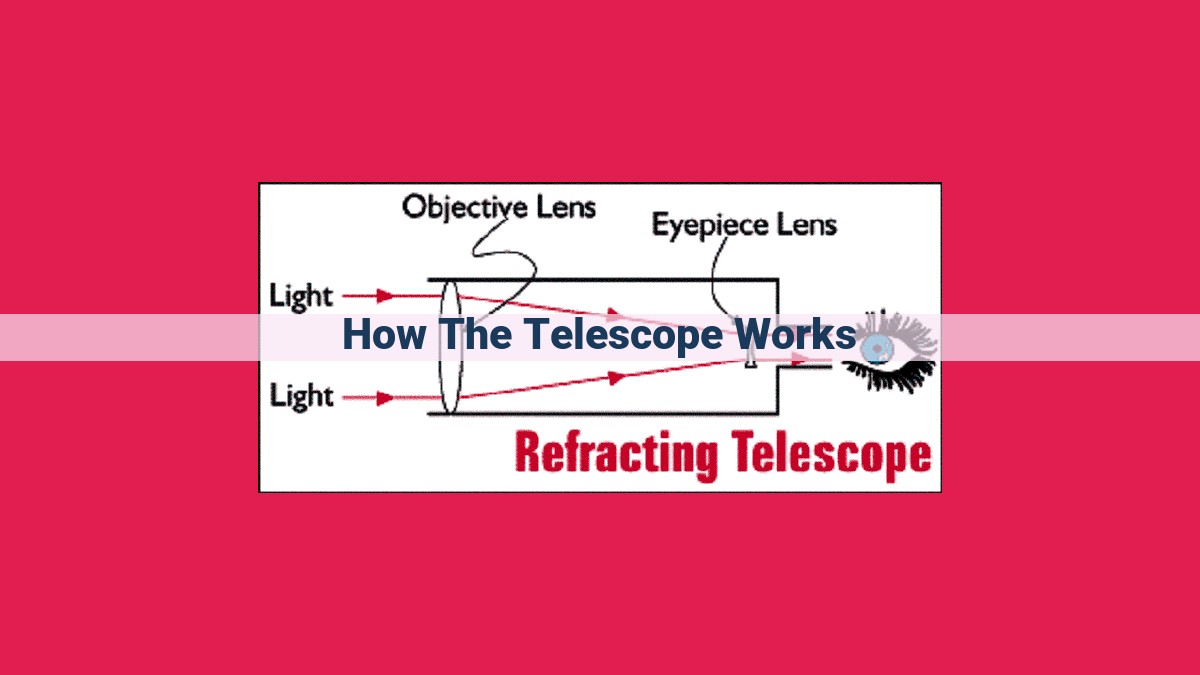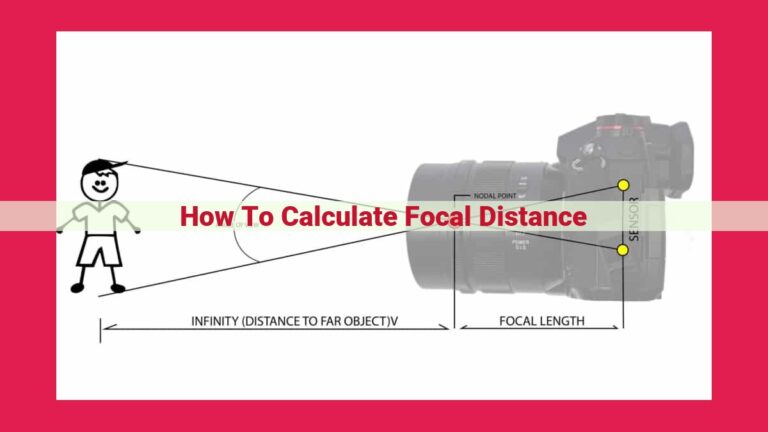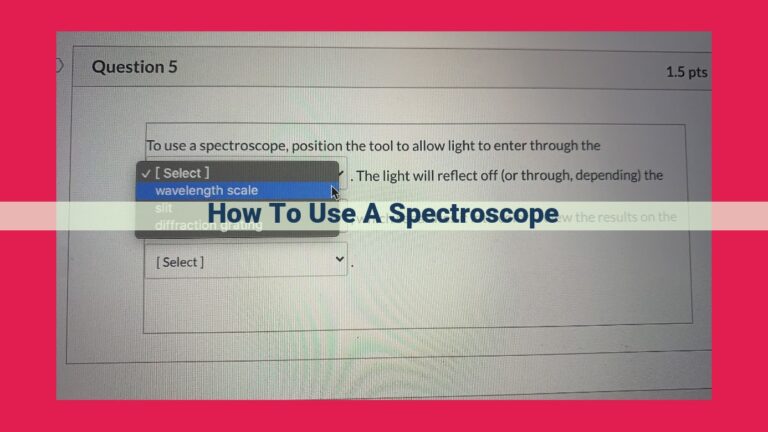How Telescopes Unlock The Secrets Of The Cosmos: A Guide To Their Functionality And Impact

- How Telescopes Work: Telescopes gather and magnify light from distant objects. By capturing more light, they increase the visibility of faint celestial bodies. They also magnify objects, making them appear closer and revealing details that would otherwise be invisible to the unaided eye. Additionally, telescopes enhance resolution, enabling astronomers to distinguish between closely spaced objects and discern fine structures.
The Wonders of Telescopes: Unveiling the Secrets of the Cosmos
Intro:
Embark on an astronomical adventure as we delve into the fascinating world of telescopes. These extraordinary tools have transformed our understanding of the universe, allowing us to gaze upon distant stars, peer into enigmatic nebulae, and witness the majesty of galaxies far, far away.
How Telescopes Work: Capturing the Light of the Night Sky
- Light-Gatherers: Telescopes act as portals to the cosmos, collecting and focusing light from distant objects.
- Magnification: By manipulating lenses or mirrors, telescopes magnify the gathered light, making distant objects appear closer and larger.
- Resolution: Using principles of optics, telescopes resolve fine details, revealing intricate structures and features that would otherwise remain hidden to the naked eye.
Telescope Characteristics: Understanding the Key Features
- Light-Gathering Power (Aperture): Measured as the diameter of the telescope’s objective lens or mirror, aperture determines the telescope’s ability to collect light and resolve fine details.
- Magnification: The ratio of the focal length of the telescope to that of the eyepiece, magnification increases the angular size of objects but also reduces the field of view.
- Resolution: Governed by diffraction and atmospheric conditions, resolution limits the telescope’s ability to distinguish between two closely spaced objects.
- Field of View: The angular size of the area visible through the telescope, larger field of views allow for broader observations.
Types of Telescopes: Exploring the Diverse Options
a. Refractors:
– Employ lenses to gather and focus light.
– Benefits: Clear images with minimal aberration, suitable for both terrestrial and astronomical observations.
– Drawbacks: Limited aperture size due to the weight and cost of large lenses.
b. Reflectors:
– Utilize mirrors to gather and focus light.
– Benefits: Larger aperture sizes at lower cost, ideal for deep-sky observations.
– Drawbacks: Can suffer from coma aberration at the edge of the field of view.
c. Catadioptric:
– Combine lenses and mirrors to achieve a compact design.
– Benefits: Relatively lightweight and portable, with minimal aberration.
– Drawbacks: Middle ground in terms of aperture size and resolution.
d. Eyepiece Telescopes:
– Small, simple telescopes ideal for birdwatching, nature observation, and astronomy.
e. Objective Lens Telescopes:
– Used for various applications, including optical sights, spotting scopes, and small astronomical telescopes.
Understanding Eyepieces and Objectives: The Magnification Equation
- Eyepieces: Determine the magnification and field of view, lower focal length
eyepieces provide higher magnification. - Objective Lenses: Collect and focus light, their focal length inversely affects magnification in combination with the eyepiece.
Telescope Characteristics: Light-Gathering Power, Magnification, Resolution, and Field of View
In the realm of astronomy, telescopes act as our cosmic windows, empowering us to explore the vast expanse of the cosmos beyond our naked-eye capabilities. Their ability to gather light, magnify objects, and resolve fine details determines their effectiveness for different astronomical observations.
Light-Gathering Power
The light-gathering power of a telescope is crucial for capturing faint celestial objects. It is determined by the telescope’s aperture, or the diameter of its primary light-collecting surface. Larger apertures collect more light, enabling astronomers to observe fainter objects and improve the clarity and detail of their observations.
Magnification
Magnification, as the name suggests, increases the apparent size of objects. In telescopes, it is primarily achieved through the use of eyepieces, which are interchangeable lenses placed at the end of the telescope. By changing the eyepieces, astronomers can adjust the magnification to suit the desired level of detail and field of view.
Resolution
Resolution refers to the telescope’s ability to distinguish between two closely spaced objects. It is determined by a combination of factors, including the diffraction limit (a natural limitation due to the wave-like nature of light) and the seeing conditions (the stability of the Earth’s atmosphere). Telescopes with higher resolution can reveal finer details and discern objects that appear blurred to the naked eye.
Field of View
The field of view refers to the area of the sky that is visible through the telescope. It is influenced by the focal length of the telescope and the magnification of the eyepiece. Wider fields of view allow astronomers to survey larger regions of the sky, while narrower fields of view provide more detailed views of specific targets.
Understanding these key characteristics is essential for astronomers to optimize their telescope choices for different astronomical pursuits. Whether exploring deep-sky objects, searching for exoplanets, or studying the intricacies of stellar phenomena, these characteristics play a vital role in shaping our cosmic observations and expanding our knowledge of the universe.
The Essential Guide to Telescopes: Unlocking the Secrets of the Cosmos
Telescopes, the cosmic eyes that pierce the darkness, have captivated humanity for centuries. Embark on a journey to unravel the wonders of these remarkable instruments, from their fundamental principles to their diverse applications in the realm of astronomy.
Chapter 1: Delving into the Heart of Telescopes
How do telescopes work? They are the gatekeepers to the universe, gathering precious photons from distant realms and magnifying them to unveil celestial mysteries. By understanding the fundamental principles of light gathering, magnification, and resolution, we can appreciate the transformative power of these scientific marvels.
Chapter 2: Deciphering Telescope Characteristics
The performance of a telescope is governed by a symphony of characteristics. Light-gathering power determines the faintest objects it can detect, while magnification reveals the intricate details of celestial bodies. Resolution governs the ability to distinguish fine features, and the field of view dictates the expanse of the cosmos visible through the lens. These intertwined factors dictate the suitability of telescopes for specific astronomical observations.
Chapter 3: The Telescope Family Tree
From ancient stargazers to modern astrophysicists, telescopes have evolved to meet the ever-changing needs of exploration. Discover the different types of telescopes, each with its unique strengths and weaknesses. Eyepiece telescopes, objective lens telescopes, reflectors, refractors, and catadioptric telescopes represent the rich tapestry of telescopic innovation, each tailored to specific celestial targets and observational goals.
Chapter 4: Unveiling the Secrets of Eyepieces and Objectives
The heart of any telescope lies in its eyepieces and objectives. Eyepieces magnify the image formed by the objective lens, customizing the viewing experience. Objectives, on the other hand, gather light from distant objects, influencing the overall performance of the telescope. Understanding their interplay of focal length and magnification empowers us to optimize the field of view and sharpen the image quality.
Chapter 5: Confronting the Diffraction Limit and Seeing
As we push the boundaries of telescopic exploration, we encounter two fundamental limitations: the diffraction limit and seeing. Diffraction, an inherent property of light, sets a boundary on the finest details telescopes can resolve. Seeing, caused by atmospheric turbulence, further blurs the image, especially in high-magnification observations. Understanding these challenges helps us appreciate the precision and patience required in astronomical endeavors.
Chapter 6: The Quest for the Perfect Telescope
Selecting the right telescope is a crucial step in unlocking the wonders of the night sky. Consider your intended use, budget, and observational conditions. Evaluate the aperture, magnification, and type of telescope that best aligns with your celestial aspirations. With careful deliberation, you can find the perfect companion for your cosmic adventures.
Types of Telescopes: Unveiling the Cosmos
Telescopes, our cosmic eyes, transport us to distant realms, revealing the secrets of the universe. From ancient lenses to modern marvels, telescopes come in various types, each designed to capture the celestial tapestry in its unique way.
Eyepiece and Objective Lens Telescopes
The simplest of telescopes, eyepiece and objective lens telescopes rely on a single lens objective to gather light and form an image. Eyepiece telescopes, portable and versatile, feature an eyepiece that magnifies the image. Objective lens telescopes, known for their wider field of view, use an objective lens to project an enlarged image directly onto a viewing screen.
Reflector Telescopes: Astronomical Giants
Harnessing the power of reflection, reflector telescopes use a curved mirror, known as a primary mirror, to collect light and focus it onto a smaller secondary mirror. This arrangement allows for larger aperture diameters, resulting in increased light-gathering power. Reflector telescopes, with their ability to gather faint starlight, are ideal for deep-space exploration.
Refractor Telescopes: Clarity and Versatility
Utilizing refraction, refractor telescopes employ a series of glass lenses to bend light, forming an image. These telescopes are known for their color correction capabilities, ensuring sharp and vibrant images. Refractors are versatile, suitable for both terrestrial and celestial observations, making them popular among amateur astronomers.
Catadioptric Telescopes: The Best of Both Worlds
Combining the strengths of both reflector and refractor designs, catadioptric telescopes use a mix of mirrors and lenses. These telescopes offer a compact and portable design while providing excellent image quality. Combining the light-gathering power of reflectors with the clarity of refractors, catadioptrics are ideal for a wide range of astronomical endeavors.
Choosing the Right Telescope: A Journey of Discovery
Selecting the perfect telescope is an exciting journey, one that requires careful consideration. Factors to ponder include intended use, budget, and observational environment. Determine the desired aperture size for light-gathering ability and consider magnification for close-up views of celestial objects. Whether you seek a portable eyepiece telescope, a deep-sky reflector, a versatile refractor, or a powerful catadioptric, there’s a telescope tailored to every cosmic explorer.
Understanding the World of Telescopes: A Guide to Types and Applications
Embark on a celestial adventure as we dive into the intriguing world of telescopes. These marvels of human ingenuity unveil the hidden wonders of the cosmos, empowering us to explore the vastness of the universe beyond our naked eyes.
A Symphony of Types
1. Refractor Telescopes: These classic telescopes utilize lenses to gather and focus light. They offer sharp images with minimal distortion, making them ideal for detailed planetary observations and lunar studies. Small and portable, refractors are suitable for beginners and casual stargazers.
2. Reflector Telescopes: Employing mirrors to collect light, reflectors offer superior light-gathering power compared to refractors. This translates to brighter and deeper observations of faint objects like galaxies and nebulae. Reflectors are typically bulkier but allow for larger apertures for enhanced light collection.
3. Catadioptric Telescopes: This hybrid design combines lenses and mirrors, providing compactness and reduced chromatic aberration. Schmidt-Cassegrain and Maksutov telescopes fall into this category, offering versatility for various astronomical pursuits.
Intended Applications
Astronomy: Telescopes are the gateway to exploring the celestial tapestry, from the moon’s cratered surface to the distant galaxies teeming with untold stories. They enable detailed observations of planets, star clusters, and nebulae.
Birding and Wildlife Observation: While not traditionally thought of for nature study, telescopes can be adapted with digiscoping adapters to capture close-up images of birds and other wildlife. This approach is particularly useful for researchers and wildlife enthusiasts.
Surveillance and Security: High-powered telescopes with enhanced zoom capabilities find applications in law enforcement, border patrols, and military reconnaissance. Their ability to detect and magnify distant objects aids in surveillance and monitoring operations.
Selecting the Perfect Telescope
Choosing the right telescope depends on your intended use and budget. Consider the following factors:
Aperture: This is the diameter of the lens or mirror, which determines the light-gathering ability and, consequently, the brightness of the images. A larger aperture means brighter and clearer observations.
Magnification: Magnification enlarges the image of the object being observed. While higher magnification may seem appealing, it can also lead to dimmer images and reduced clarity.
Type: Each type of telescope has its own advantages and disadvantages. Refractors offer sharp images, reflectors excel in light-gathering power, while catadioptric telescopes provide a balance of both.
Budget: Telescopes can range from affordable entry-level models to high-end research-grade instruments. Establish a budget and research your options to find the best telescope that meets your requirements without breaking the bank.
Understanding Eyepieces and Objectives: The Vital Components of Telescopes
In the realm of astronomy, telescopes serve as our portal to the cosmos, extending our vision beyond the naked eye’s limitations. Composed of two fundamental components, eyepieces and objective lenses play a crucial role in shaping the viewing experience and unlocking the secrets of distant celestial bodies.
Eyepieces: The Window to the Universe
The eyepiece is the lens through which we gaze into the cosmos. It magnifies the image formed by the objective lens, effectively bringing distant objects closer to the observer’s eyes. By swapping out eyepieces with different focal lengths, we can tailor the magnification level to our desired field of view and object details.
Objective Lenses: Capturing the Distant Light
The objective lens, located at the front of the telescope, is responsible for gathering and focusing light from distant objects. Its diameter, or aperture, determines the light-gathering power of the telescope. A wider aperture allows more light to enter the system, crucial for observing faint celestial objects.
The Dance of Eyepiece and Objective
The interplay between the eyepiece and objective lens creates the magnification effect. The focal length of the eyepiece is inversely proportional to the magnification. A shorter focal length eyepiece provides higher magnification, while a longer focal length eyepiece offers a wider field of view. Thus, astronomers meticulously select eyepieces based on their specific observational needs.
By understanding the role of eyepieces and objective lenses, we gain a deeper appreciation for the complexity of telescopes and their ability to unlock the wonders of the cosmos.
Understanding Eyepieces and Objectives
Eyepieces
Eyepieces are the lens you look through to view the image formed by the telescope. They determine the magnification of the telescope, which is the ratio of the apparent size of the object as seen through the eyepiece to its actual size.
Objectives
Objective lenses are located at the front of the telescope and are responsible for gathering light from the object being observed. The focal length of the objective lens determines how much the incoming light is focused, which in turn affects the magnification and field of view of the telescope.
Focal Length and Image Quality
The focal length of the objective lens determines the sharpness of the image formed by the telescope. A shorter focal length results in a wider field of view but a less sharp image. A longer focal length produces a narrower field of view but a sharper image.
Magnification and Field of View
Magnification refers to how much larger an object appears through the telescope compared to its actual size. Higher magnification means the object appears larger, but it also results in a narrower field of view. Lower magnification provides a wider field of view but makes objects appear smaller.
The focal length of the objective lens and the focal length of the eyepiece together determine the overall magnification of the telescope. A longer focal length objective lens with a shorter focal length eyepiece will produce higher magnification. Conversely, a shorter focal length objective lens with a longer focal length eyepiece will produce lower magnification.
Choosing the Right Combination
The choice of eyepiece and objective lens depends on the specific requirements of your observations. For example, a wide field of view is desirable for observing large objects like the Milky Way or star clusters. Conversely, higher magnification is necessary for observing fine details on planets, moons, or double stars.
The Eye in the Sky: Unraveling the Secrets of Telescopes
Telescopes, the gatekeepers to the cosmos, have captivated humankind for centuries, unveiling wonders beyond our naked-eye reach. In this cosmic exploration, we embark on a journey to understand these celestial instruments, deciphering their principles, characteristics, and diverse forms.
How Telescopes Work: A Symphony of Light and Magnification
At their core, telescopes are light-gathering machines, harnessing photons from distant objects and focusing them to create magnified images. This optical magic is achieved through the artful arrangement of lenses or mirrors. Lenses, like a glass of water, bend light, while mirrors, akin to polished surfaces, reflect it. By carefully controlling the curvatures and positioning of these elements, telescopes bring the heavens closer, presenting us with a detailed tapestry of celestial wonders.
Telescope Characteristics: Unlocking Performance and Suitability
To navigate the celestial expanse effectively, astronomers rely on several key telescope characteristics. Light-gathering power, akin to a lighthouse’s beam, determines the telescope’s ability to capture faint objects. Magnification amplifies the apparent size of celestial bodies, allowing us to discern finer details. Resolution, the telescope’s ability to distinguish between closely spaced objects, reveals the delicate intricacies of galaxies and planets. Finally, field of view, the area visible through the telescope, influences the breadth of our cosmic gaze.
Types of Telescopes: A Kaleidoscope of Celestial Explorers
From the humble eyepiece telescope to the colossal observatory giants, telescopes come in a spectrum of designs, each tailored to specific astronomical quests. Eyepiece telescopes, the original celestial peepholes, offer a direct view of the heavens. Objective lens telescopes introduce an additional lens, enhancing magnification and image quality. Reflector telescopes, utilizing mirrors, gather more light, delving deeper into the cosmic abyss. Refractor telescopes, employing lenses, provide crisp, aberration-free images. Catadioptric telescopes, a hybrid design, merge the advantages of both reflectors and refractors, delivering superior performance in a compact form.
Understanding Eyepieces and Objectives: Tweaking the Cosmic Focus
Eyepieces, akin to the telescope’s eyes, magnify the image formed by the objective lens or mirror. Their focal length, the distance between the lens and the focal plane, determines the field of view and magnification. Objective lenses, the light-gathering element, regulate the telescope’s resolving power and light-gathering capacity. Understanding the interplay between these components empowers astronomers to optimize their observational experience.
Diffraction Limit and Seeing: Unveiling the Limits of Resolution
Every telescope faces two fundamental limitations: the diffraction limit and seeing. The diffraction limit, an intrinsic property of light, restricts the smallest resolvable detail a telescope can discern. Seeing, the atmospheric turbulence that distorts starlight, further degrades resolution, especially for ground-based telescopes. These factors guide astronomers in selecting telescopes suited to their specific research objectives and observing conditions.
Choosing the Right Telescope: Navigating the Celestial Supermarket
Choosing the right telescope is like picking the perfect mount for an epic quest. Consider your intended use, whether it’s stargazing, astrophotography, or scientific research. Set a budget that aligns with your aspirations. Evaluate observational conditions, factoring in light pollution and seeing conditions. By comprehending the principles, characteristics, and types of telescopes, you can embark on a cosmic voyage tailored to your unique needs and desires.
How Telescopes Work and Their Profound Impact on Astronomy
From the vast expanse of galaxies to the intricate details of celestial bodies, telescopes have played an integral role in unlocking the cosmos and revolutionizing our understanding of the universe. This celestial guide delves into the fundamentals of how telescopes work, their key characteristics, and how they have empowered astronomers to unravel the secrets hidden in the night sky.
The Principles of Telescopes: Unlocking the Secrets of the Cosmos
Telescopes gather light from distant objects, allowing us to magnify them, revealing details otherwise invisible to the naked eye. By capturing and focusing this faint light, telescopes enable us to observe the celestial sphere with unprecedented clarity. The magnified images unveil breathtaking cosmic landscapes, from sparkling star clusters to swirling galaxies.
Telescope Characteristics: A Deeper Dive into Optical Capabilities
The capabilities of telescopes are defined by a suite of characteristics, including light-gathering power, magnification, resolution, and field of view. Each aspect influences the telescope’s performance and suitability for various astronomical observations. Light-gathering power determines how much light a telescope can capture, crucial for observing faint celestial objects. Magnification enhances the apparent size of celestial bodies, bringing them closer for detailed scrutiny. Resolution unveils fine details by distinguishing between closely spaced objects, allowing us to discern even minute features. Field of view defines the extent of the visible sky, informing the scope of astronomical observations.
A Symphony of Telescope Types: Embracing Optical Diversity
The world of telescopes encompasses a captivating array of types, each tailored to specific astronomical pursuits. Eyepiece telescopes employ lenses to magnify the image, while objective lens telescopes use an objective lens as the primary light-gathering element. Reflector telescopes utilize mirrors to gather and focus light, while refractor telescopes rely solely on lenses. Catadioptric telescopes ingeniously combine mirrors and lenses, blending their strengths for enhanced performance.
Eyepieces and Objectives: Unraveling the Secrets of Magnification
Eyepieces and objective lenses play critical roles in telescopes. Eyepieces magnify the image formed by the objective lens, while objective lenses control light-gathering power and focal length. The focal length of the objective lens, measured in millimeters, determines the magnification when combined with a specific eyepiece. This interplay of focal lengths and eyepieces allows astronomers to tailor their observations to suit different celestial objects and desired magnification levels.
Diffraction Limit and Seeing: The Ultimate Resolution Barrier
The diffraction limit, a fundamental constraint in optics, dictates the finest detail that telescopes can resolve. This limit is determined by the wavelength of light and the aperture (diameter) of the telescope. Additionally, atmospheric turbulence, known as seeing, introduces distortions that further degrade resolution, limiting the ability of telescopes to discern the most intricate celestial structures.
Choosing the Right Telescope: Gearing Up for Cosmic Exploration
Selecting the appropriate telescope is paramount to unlocking the astronomical wonders that await. Consider the intended use, budget, and observational conditions when making your decision. Aperture, magnification, and type are key factors to evaluate. For deep-sky observations, a telescope with a larger aperture is recommended. For observing planets and double stars, magnification becomes a more critical consideration. And for portability and ease of setup, compact telescopes excel.
By embracing the wonders of telescopes, we embark on an awe-inspiring journey through the cosmos. They empower us to witness the celestial tapestry in all its glory, unraveling the mysteries that lie beyond our earthly gaze. So, let us turn our eyes to the heavens, guided by the transformative power of telescopes, and let the universe unfold its infinite wonders before us.
A Journey to the Stars: Choosing the Right Telescope
Embarking on a journey through the cosmos starts with selecting the perfect telescope, a gateway to unraveling the celestial wonders. Whether you’re an aspiring astronomer or a seasoned stargazer, understanding the nuances of telescopes will empower you to choose the ideal companion for your cosmic explorations.
Unveiling the Types of Telescopes
Telescopes come in a myriad of designs, each tailored to specific observational goals. Eyepiece telescopes, also known as spotting scopes, provide a sharp view of terrestrial objects but are limited in their ability to explore the heavens. Objective lens telescopes, like binoculars, offer a wider field of view, making them suitable for observing celestial bodies in dim lighting conditions.
Reflector telescopes harness the power of mirrors to gather and focus light, boasting greater light-gathering capacity for capturing faint objects. Refractor telescopes, on the other hand, utilize lenses to bend and magnify light, delivering sharper images with less distortion. Catadioptric telescopes ingeniously combine mirrors and lenses, offering a compact design and excellent optical performance.
Deciphering Telescope Characteristics
The effectiveness of a telescope hinges on its key characteristics:
- Light-gathering power: Measured by the aperture, this determines the amount of light the telescope can collect, impacting the visibility of faint objects.
- Magnification: Enlarges the image, enhancing the apparent size of celestial bodies. However, excessive magnification can result in blurry images.
- Resolution: Denotes the ability to distinguish fine details, limited by the telescope’s diffraction limit.
- Field of view: Specifies the area of the sky the telescope can observe, influential in locating and tracking objects.
Selecting the Perfect Telescope
Navigating the vast array of telescopes requires meticulous consideration of your intended use, budget, and observing conditions.
- Intended use: Are you primarily interested in planetary observations, deep-sky gazing, or a versatile all-rounder? Matching your telescope to your observing goals ensures a fulfilling experience.
- Budget: Telescopes span a wide price range. Determine your financial constraints and explore options that fit within your budget.
- Observing conditions: Local light pollution and atmospheric clarity significantly influence telescope performance. Choose a telescope that aligns with your typical observing conditions.
Choosing the right telescope is an essential step that empowers you to delve into the wonders of the night sky. By understanding the different types and characteristics of telescopes, you can make an informed decision that will unlock a celestial adventure like no other. Let the stars guide your journey as you embark on a path filled with cosmic discoveries and awe-inspiring moments.
Understanding Telescopes: A Comprehensive Guide for Stargazers
In the vast expanse of the cosmos, humans have long gazed upward, marveling at the celestial beauty above. Telescopes have revolutionized our ability to explore these cosmic wonders, bringing the distant realms within our reach. Whether you’re an aspiring astronomer or simply curious about the night sky, understanding the factors to consider when choosing a telescope is crucial.
Aperture: The Gateway to Light
- Definition: Aperture refers to the diameter of the telescope’s objective lens or mirror.
- Importance: A larger aperture allows the telescope to gather more light, which is essential for observing faint objects and achieving higher resolution.
Magnification: Bridging the Cosmic Divide
- Definition: Magnification refers to the telescope’s ability to make objects appear closer.
- Impact: Higher magnification allows you to view finer details, but it also reduces the field of view and can introduce image distortion.
Type: Tailoring the Telescope to Your Needs
- Eyepiece Telescopes: Best suited for casual stargazing and observing nearby celestial objects.
- Objective Lens Telescopes: Offer higher magnification and light-gathering power, ideal for observing distant planets, galaxies, and deep-sky objects.
- Reflector Telescopes: Utilize mirrors instead of lenses, providing high light-gathering capability and affordability.
- Refractor Telescopes: Use lenses to gather light, offering sharp images but requiring a larger tube length for higher magnification.
- Catadioptric Telescopes: Combine elements of both reflectors and refractors, achieving high light-gathering power in a compact design.
Choosing the Right Telescope: A Balanced Approach
Selecting the ideal telescope depends on a blend of factors, including:
- Intended Use: Consider the objects you wish to observe, whether it’s planets, galaxies, or deep-sky objects.
- Budget: Telescopes range in price, so determine your financial limitations and explore options that fit within your budget.
- Observational Conditions: Assess the light pollution levels and atmospheric conditions in your observing location.
By considering aperture, magnification, and type, you can make an informed decision that will enhance your celestial exploration. Join the ranks of stargazers, unravel the mysteries of the universe, and witness the boundless wonders that lie hidden in the night sky.




